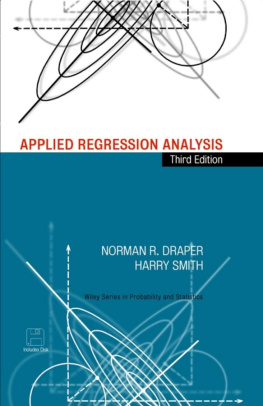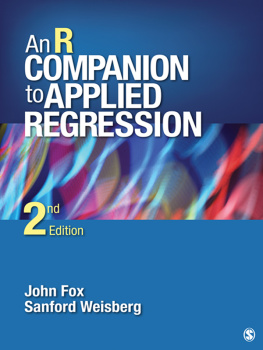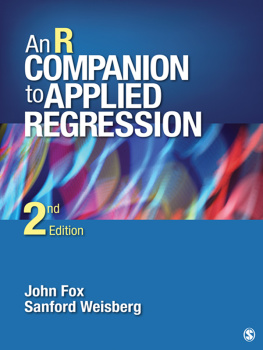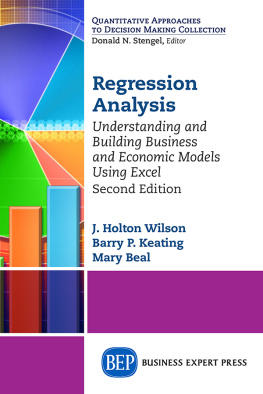Draper Norman R. - Applied Regression Analysis
Here you can read online Draper Norman R. - Applied Regression Analysis full text of the book (entire story) in english for free. Download pdf and epub, get meaning, cover and reviews about this ebook. year: 2014, publisher: Wiley, genre: Children. Description of the work, (preface) as well as reviews are available. Best literature library LitArk.com created for fans of good reading and offers a wide selection of genres:
Romance novel
Science fiction
Adventure
Detective
Science
History
Home and family
Prose
Art
Politics
Computer
Non-fiction
Religion
Business
Children
Humor
Choose a favorite category and find really read worthwhile books. Enjoy immersion in the world of imagination, feel the emotions of the characters or learn something new for yourself, make an fascinating discovery.
- Book:Applied Regression Analysis
- Author:
- Publisher:Wiley
- Genre:
- Year:2014
- Rating:5 / 5
- Favourites:Add to favourites
- Your mark:
- 100
- 1
- 2
- 3
- 4
- 5
Applied Regression Analysis: summary, description and annotation
We offer to read an annotation, description, summary or preface (depends on what the author of the book "Applied Regression Analysis" wrote himself). If you haven't found the necessary information about the book — write in the comments, we will try to find it.
Applied Regression Analysis — read online for free the complete book (whole text) full work
Below is the text of the book, divided by pages. System saving the place of the last page read, allows you to conveniently read the book "Applied Regression Analysis" online for free, without having to search again every time where you left off. Put a bookmark, and you can go to the page where you finished reading at any time.
Font size:
Interval:
Bookmark:


This book is printed on acid-free paper. 
Copyright 1998 by John Wiley & Sons, Inc. All rights reserved.
Published simultaneously in Canada.
No part of this publication may be reproduced, stored in a retrieval system or transmitted in any form or by any means, electronic, mechanical, photocopying, recording, scanning or otherwise, except as permitted under Sections 107 or 108 of the 1976 United States Copyright Act, without either the prior written permission of the Publisher, or authorization through payment of the appropriate per-copy fee to the Copyright Clearance Center, 222 Rosewood Drive, Danvers, MA 01923, (978) 750-8400, fax (978) 750-4470. Requests to the Publisher for permission should be addressed to the Permissions Department, John Wiley & Sons, Inc., Ill River Street, Hoboken, NJ 07030, (201) 748-6011, fax (201) 748-6008.
Library of Congress Cataloging-in-Publication Data:
Draper, Norman Richard.
Applied regression analysis / N.R. Draper, H. Smith. 3rd ed.
p. cm. (Wiley series in probability and statistics. Texts and references section)
A Wiley-Interscience publication.
Includes bibliographical references (p. ) and index.
ISBN 0-471-17082-8 (acid-free paper)
1. Regression analysis. I. Smith, Harry, 1923 . II. Title.
III. Series.
QA278.2.D7 1998
519.5'36dc21 97-17969
Preface to the Third Edition
The second edition had 10 chapters; this edition has 26. On the whole (but not entirely) we have chosen to use smaller chapters, and so distinguish more between different types of material. The tabulation below shows the major relationships between second edition and third edition sections and chapters.
Material dropped consists mainly of second edition Sections 6.8 to 6.13 and 6.15, Sections 7.1 to 7.6, and Chapter 8. New to this edition are Chapters 16 on multicollinearity, 18 on generalized linear models, 19 on mixture ingredients, 20 and 21 on the geometry of least squares, 25 on robust regression, and 26 on resampling procedures. Small revisions have been made even in sections where the text is basically unchanged. Less prominence has been given to printouts, which nowadays can easily be generated due to the excellent software available, and to references and bibliography, which are now freely available (either in book or computer form) via the annual updates in Current Index to Statistics. References are mostly given in brief either in situ or close by, at the end of a section or chapter. Full references are in a bibliography but some references are also given in full in sections or within the text or in exercises, whenever this was felt to be the appropriate thing to do. There is no precise rule for doing this, merely the authors' predilection. Exercises have been grouped as seemed appropriate. They are intended as an expansion to the text and so most exercises have full or partial solutions; there are a very few exceptions. One hundred and one true/false questions have also been provided; all of these are in true form to prevent readers remembering erroneous material. Instructors can reword them to create false questions easily enough. Sections 24.5 and 24.6 have some duplication with work in Chapter 20, but we decided not to eliminate this because the sections contain some differences and have different emphases. Other smaller duplications occur; in general, we feel that duplication is a good feature, and so we do not avoid it.
Our viewpoint in putting this book together is that it is desirable for students of regression to work through the straight line fit case using a pocket calculator and then to proceed quickly to analyzing larger models on the computer. We are aware that many instructors like to get on to the computer right away. Our personal experience is that this can be unwise and, over the years, we have met many students who enrolled for our courses saying I know how to put a regression on the computer but I don't understand what I am doing. We have tried to keep such participants constantly in mind.
We have made no effort to explain any of the dozens of available computing systems. Most of our specific references to these were removed after we received reviews of an earlier draft. Reviewers suggested we delete certain specifics and replace them by others. Unfortunately, the reviewers disagreed on the specifics! In addition, many specific program versions quickly become obsolete as new versions are issued. Quite often students point out to us in class that the new version of BLANK does (or doesn't!) do that now. For these reasons we have tried to stay away from advocating any particular way to handle computations. A few mild references to MINITAB (used in our University of Wisconsin classes) have been retained but readers will find it easy to ignore these, if they wish.
We are grateful for help from a number of people, many of these connected with N. R. Draper at the University of Wisconsin. Teaching assistants contributed in many ways, by working new assignments, providing class notes of lectures spoken but not recorded, and discussing specific problems. Former University of Wisconsin student Dennis K. J. Lin, now a faculty member at Pennsylvania State University, contributed most in this regard. More generally, we profited from teaching for many years from the excellent Wiley book Linear Regression Analysis, by George A. F. Seber, whose detailed algebraic treatment has clearly influenced the geometrical presentations of Chapters 20 and 21.
N. R. Draper is grateful to the University of Wisconsin and to his colleagues there for a timely sabbatical leave, and to Professor Friedrich Pukelsheim of the University of Augsburg, Germany, for inviting him to spend the leave there, providing full technical facilities and many unexpected kindnesses as well. Support from the German Alexander von Humboldt Stiftung is also gratefully acknowledged. N. R. Draper is also thankful to present and former faculty and staff at the University of Southampton, particularly Fred (T. M. F.) Smith, Nye (J. A.) John (now at Waikato University, New Zealand), Sue Lewis, Phil Prescott, and Daphne Turner, all of whom have made him most welcome on annual visits for many years. The enduring influence of R. C. Bose (19011987) is also gratefully acknowledged.
The staff at the Statistics Department, Mary Esser (staff supervisor, retired), Candy Smith, Mary Ann Clark (retired), Wanda Gray (retired), and Gloria Scalissi, have all contributed over the years. Our special thanks go to Gloria Scalissi who typed much of a difficult and intricate manuscript.
For John Wiley & Sons, the effects of Bea Shube's help and wisdom linger on, supplemented more recently by those of Kate Roach, Jessica Downey, and Steve Quigley. We also thank Alison Bory on the editorial side and Production Editor Lisa Van Horn for their patience and skills in the final stages.
We are grateful to all of our reviewers, including David Belsley and Richard (Rick) Chappell and several anonymous ones. The reviews were all very helpful and we followed up most of the suggestions made, but not all. We ourselves have often profited by reading varying presentations in different places and so we sometimes resisted changing our presentation to conform to presentations elsewhere.
Many others contributed with correspondence or conversation over the years. We do not have a complete list, but some of them were Cuthbert Daniel, Jim Durbin, Xiaoyin (Frank) Fan, Conrad Fung, Stratis Gavaris, Michael Haber, Brian Joiner, Jane Kawasaki, Russell Langley, A. G. C. Morris, Ella Munro, Vedula N. Murty, Alvin P. Rainosek, J. Harold Ranck, Guangheng (Sharon) Shen, Jake Sredni, Daniel Weiner, William J. Welch, Yonghong (Fred) Yang, Yuyun (Jessie) Yang, and Lisa Ying. Others are mentioned within the text, where appropriate. We are grateful to them all.
Next pageFont size:
Interval:
Bookmark:
Similar books «Applied Regression Analysis»
Look at similar books to Applied Regression Analysis. We have selected literature similar in name and meaning in the hope of providing readers with more options to find new, interesting, not yet read works.
Discussion, reviews of the book Applied Regression Analysis and just readers' own opinions. Leave your comments, write what you think about the work, its meaning or the main characters. Specify what exactly you liked and what you didn't like, and why you think so.








